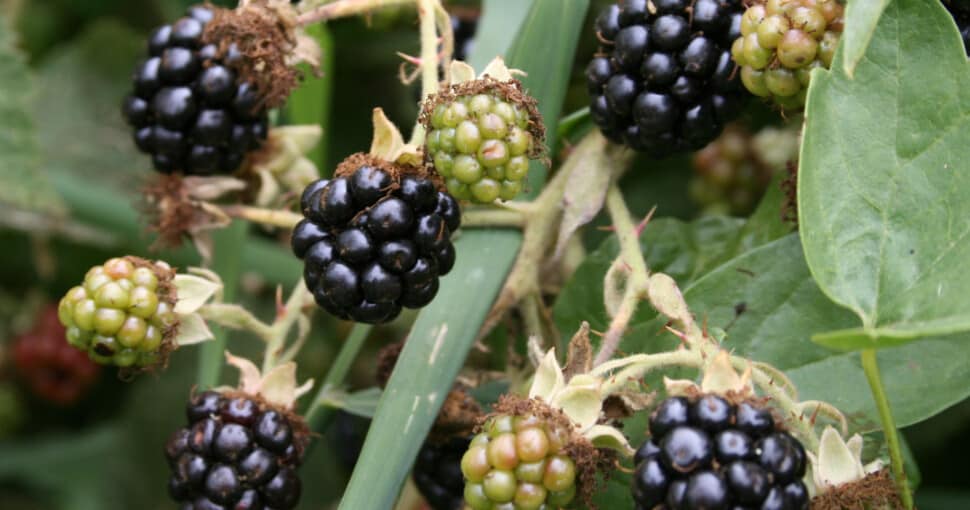Blackberries are a superfood as they contain vitamin A, a range of B vitamins, vitamin C, vitamin E, and vitamin K. They provide a wealth of dietary minerals, fiber, and amino acids and are excellent antioxidants. Blackberries have been eaten and used as medicines for centuries by many different cultures.
Most people are familiar with blackberries, but it is interesting to note they are not true berries botanically. Each little round blackberry ‘ball’ is regarded as an individual fruit called a drupe. The blackberry fruit develops from white or pale pink flowers.
Blackberries grow on thorny perennial bushes that are also known as brambles. They belong to the genus Rubus and the Rose family (Rosaceae). In the United States, blackberries are sometimes referred to as caneberries. Three hundred and seventy-five blackberry species grow natively in Europe, North and South America, Asia and parts of Africa.
Blackberries have a central cane (primocane) that grows in the first year, followed by lateral canes in the second year. The canes have sharp prickles, which make blackberry bramble thickets impenetrable. Prickle-less Blackberry cultivars have been developed. The central cane grows from nine feet to thirty feet long.
The lateral canes arch over and bury themselves in the soil, creating new plants. They spread rapidly and quickly, colonize disturbed soil, ditches, and vacant land. They grow in various soils in forests, hedgerows, hilly slopes, and scrub areas.
1. Dewberries
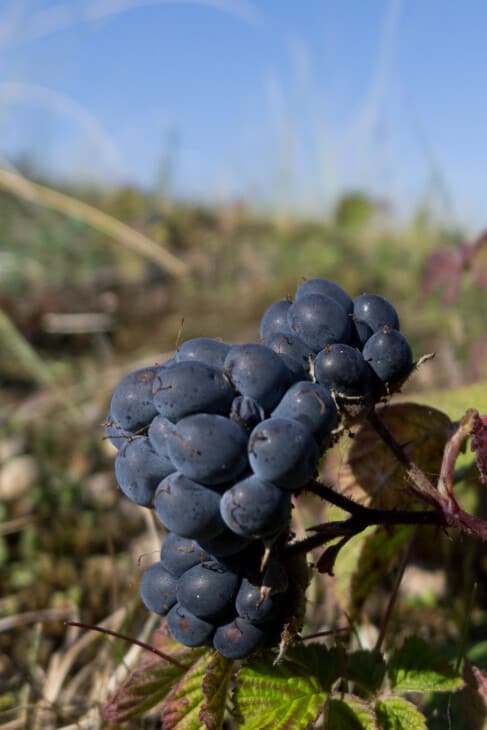
Dewberries, like blackberries, belong to the Rubus genus and Rosaceae family. They grow naturally throughout Northern Europe and North America. They are sometimes called ground berries. Dewberries usually take four to five years to mature and begin producing fruit.
Dewberries are similar to blackberries. The drupe clusters are rounded and smaller than blackberries. They are known as dewberries due to the waxy droplets that occur on the berries. The berries may be black, red, or light blue. The berries ripen from late spring to summer, depending on the climate.
Dewberry plants grow on canes similar to blackberries, but they are usually smaller growing to two feet long as a shrub. The stems have red hairs with thorns or prickles. The leaves are green with toothed edges and change colors to red and orange in fall. Dewberries can reproduce from seeds or rhizomes.
Dewberry plants may grow in full sun or areas with direct sun for five or six hours daily. Dewberries are not demanding plants and will grow in a variety of soils. They will benefit from a trellis to train the canes.
2. Blackberry Lily
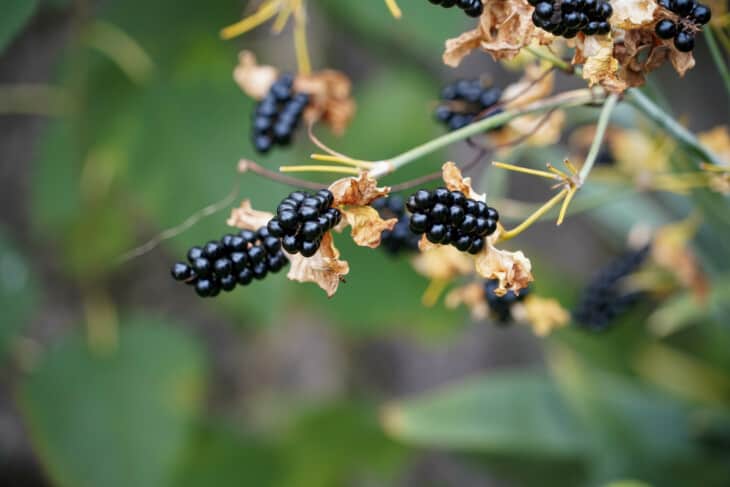
Blackberry Lily (Belamcanda chinensis) may also be known as Iris domestica and the Leopard Lily. This plant is part of the family Iridaceae and is not a true lily. The Blackberry Lily is native to Eastern Russia, Japan, and China. Blackberry lilies produce shiny black seed clusters similar to blackberries.
Blackberry Lily is a perennial ornamental herb that can grow to approximately three feet. Like other irises, it grows in clumps from rhizomes. The leaves are flat, strap-like, and arranged in a fan. They are varying shades of green but generally a dark green. The leaves can grow up to ten inches long.
Long stems that can be up to four feet tall give rise to flowers. The flowers are orange or yellow with red spots, giving rise to the name Leopard Lily. They have six petals and, due to their stem length, benefit from being staked. The flowers only last for a day, but the plant produces multiple blooms in succession over the summer.
The flowers give rise to a green pear-shaped capsule. The green becomes tan as the seed pod dries. Eventually, the seed pod opens to reveal the black clusters of seeds that last for a long period on the plant. Blackberry Lilies grow in full or partial sunlight in a variety of soils.
3. Mulberry Tree
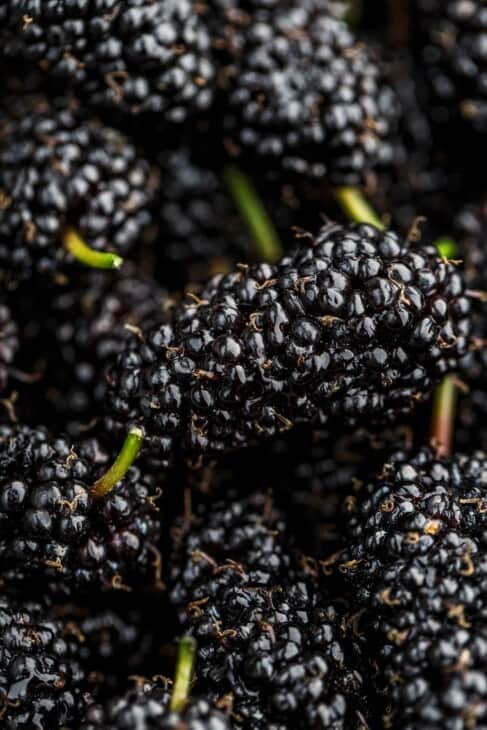
Mulberries are deciduous trees from the genus Morus and the family Moraceae. There are sixty-four species and three types; white (Morus alba), red (Morus rubra), and black (Morus nigra) mulberries. They produce berries similar to blackberries and are indigenous to Europe, Southern Africa, Asia, and North and South America.
Mulberries are tall trees and can grow up to seventy-nine feet tall and forty feet wide. Gardeners should plant their mulberry trees in sites where they do not need pruning. They suffer stress from pruning, and it should be avoided. They grow best in nutrient-rich soil with good drainage. Full or partial sunlight is best suited for mulberry trees, depending on the climate.
Mulberry trees are fast-growing with extensive, invasive roots. It is important to choose a site where mulberry trees cannot damage building foundations, septic tanks, or paving. Mulberry trees self-seed and quickly become invasive. In many countries, they are regarded as undesirable species. Sterile trees can be bought at nurseries which eliminates the problem of self-seeding.
Mulberry leaves are green with serrated edges. Young leaves may be lobed but lose them as the leaf increases in size. They are eaten by silkworms and, as a result, are crucial to the silk industry. Mulberries are eaten raw or used for jams, jellies, and tarts. They should not be eaten when unripe, as they can cause diarrhea, stomach cramps, nausea, and vomiting.
Related: Are Mulberries Poisonous?
4. Youngberries
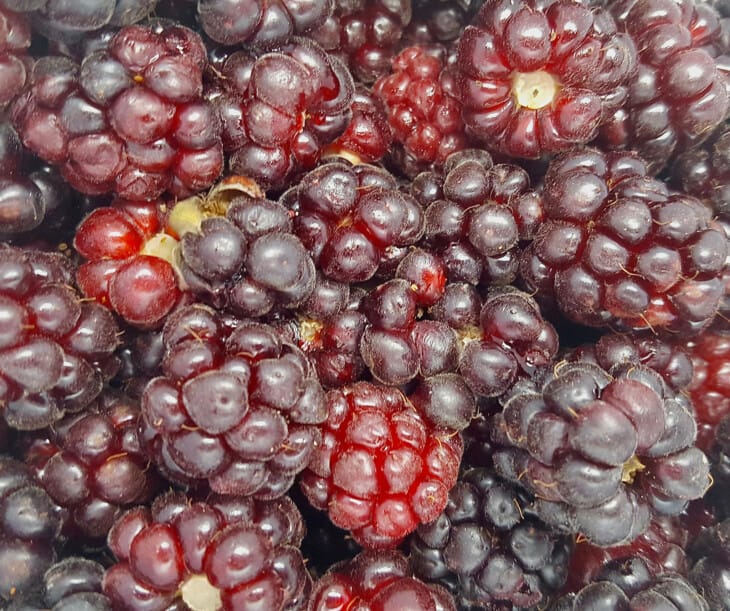
Like blackberries, youngberries (Rubus cecaesius or Rubus urcinus) are part of the Rosaceae family. They are a hybrid plant of blackberries, dewberries, and raspberries. They are cultivated as a crop on fruit farms in Oregon in the United States. They are also grown in the Western Cape in South Africa, New Zealand, and Australia.
Youngberries produce clusters of drupes or berries similar to blackberries. The berries are red-black, or deep wine, sweet and high in vitamins and minerals. Tannins, pectin, and flavonoids may be used for medicinal purposes. The plants take three years to mature and produce fruit. Like blackberries, they grow on canes that may be up to twenty-three feet tall.
Youngberry canes need to be staked on a trellis or fence. They grow best in full sunlight and need fertilization to produce good yields. Youngberry cultivars may have thorns or be thornless. The berries do not grow naturally anywhere and are only seen in cultivated fields. Youngberries are generally considered to be sweeter and tastier than blackberries.
Due to their close relationship, blackberry and youngberry leaves are very similar. Youngberries must be well-watered consistently to allow the fruit to develop maximally.
5. Salmonberry Tree
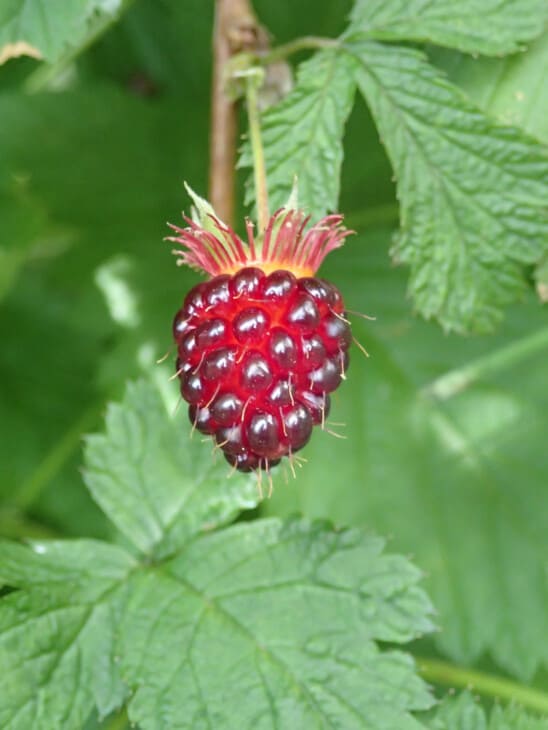
Salmonberry trees (Rubus spectabilis) is a close relation to blackberries. They grow indigenously along the Pacific coast of North America from Alaska in the north to California. They may also be found in eastern Asia. Salmonberry trees are generally found in damp areas associated with water but may grow in disturbed soil, such as along the sides of roads.
Salmonberry trees produce berries similar to blackberries, although they are rounder like raspberries. The berries are orange or yellow and sometimes have a pink tint. The fruit arises from large, showy pink, red, or magenta flowers, showcasing their membership of the Rosaceae family.
Like blackberries, the Salmonberry tree has leaves with serrated edges. It grows as a large shrub or tree and can be up to twelve feet tall. The golden or brown stem of the Salmonberry tree is woody and covered in fine thorns or prickles. The bark of the stem becomes papery and peels as the plant matures.
Like blackberries, Salmonberries are edible. They are not as tasty as blackberries, and people use them for jams and jellies. The taste is affected by the climate and soil. Many wild animals and birds feed on Salmonberries.

